A tale of three Triguns
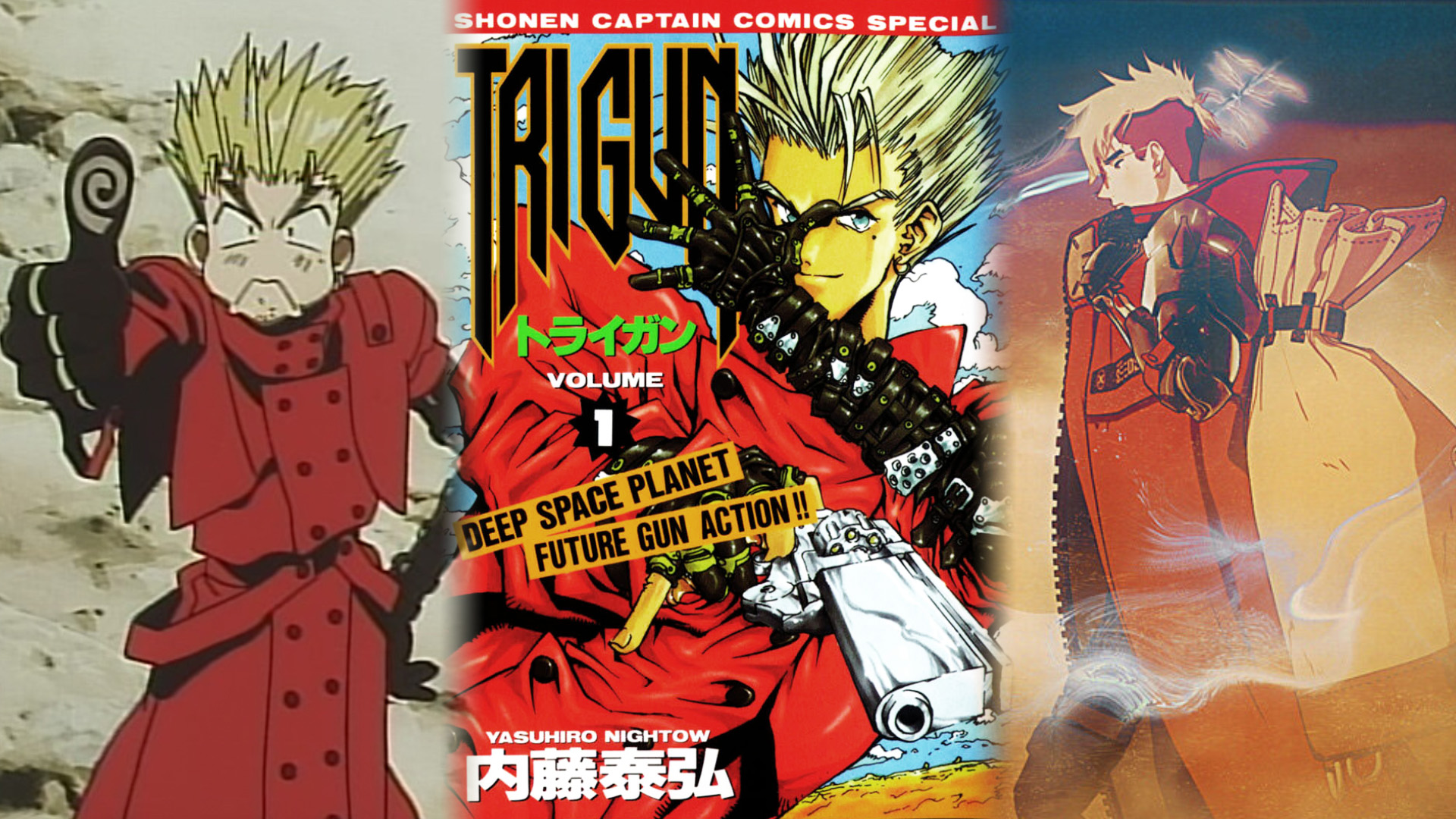
Recently, Anthony and I watched the original 1998 Trigun anime, one of my boyfriend’s favorites that I'd always meant to get around to. I enjoyed it a lot. Immediately after this, we figured we'd watch Orange's modernized CGI take on the series from last year, Trigun Stampede, so that we could compare and contrast the two while the original was still fresh in our minds. I enjoyed this new take significantly less. Alongside Stampede, I also decided to read through the entirety of Yasuhiro Nightow’s comparatively obscure Trigun manga, since I was curious about the source material both wildly different adaptations drew upon.
In the end, what I found was a series with no single definitive version of the story, each depicting different events and having their own unique pros and cons. BUT... I still enjoyed the 1998 anime the best of the three. Let me ramble a bit about why that is.
This will contain spoilers for every currently released version of Trigun.
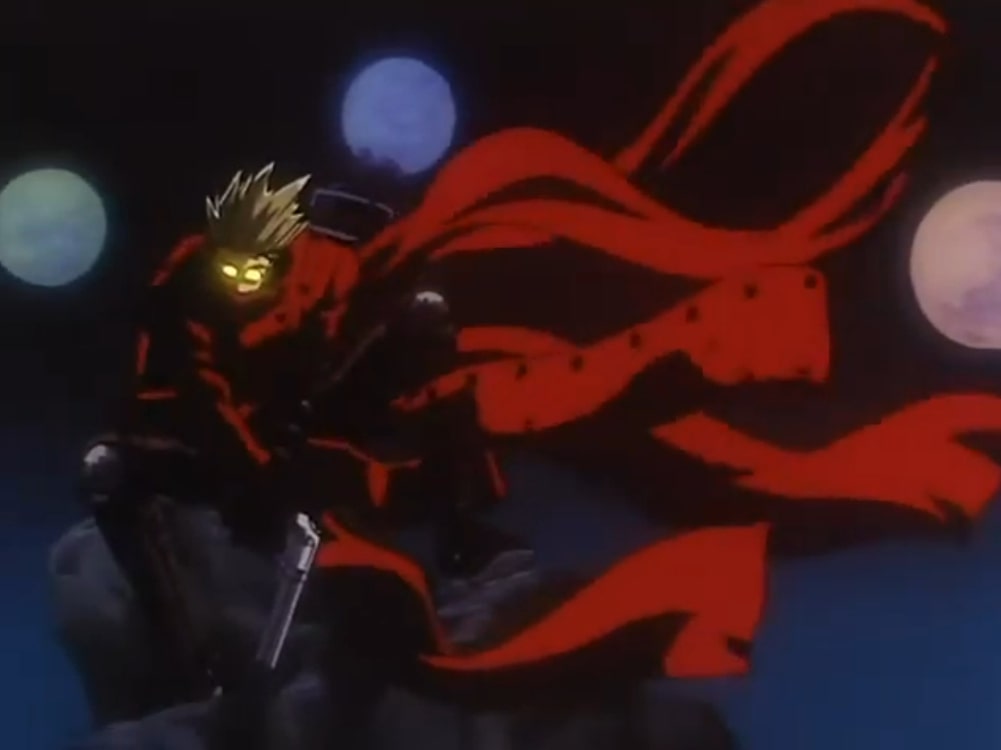
Vash the Stampede
Much of Trigun’s appeal comes down to its protagonist, Vash the Stampede. The opening minutes of the 1998 anime serve to establish the mythology surrounding the character. Vash is the most notorious man on the desert planet of Gunsmoke (or No Man’s Land in the manga and Trigun Stampede), so widely feared that tons of lesser outlaws have taken to impersonating him as an intimidation tactic. He’s earned himself the title of “The Humanoid Typhoon,” a one-man disaster who apparently singlehandedly wiped out the city of July, along with a $$60,000,000,000 double dollar bounty. He apparently causes so much damage that our point of view characters for much of the early action, Meryl Stryfe and Milly Thompson, are insurance agents sent on a globetrotting journey specifically to evaluate Vash-related damage claims. Even the opening is little more than a bunch of shots of Vash posing to look as stoic and badass as possible, his revolver drawn and his red coat billowing in the wind, as an electric guitar jams out.
And then Meryl and Milly actually meet him, and we learn that this outlaw who allegedly leveled an entire city is apparently a pacifist, a coward, an idiot, and a total goofball who mostly seems to win fights via a combination of slapstick antics and sheer luck. Much of the entertainment of the early episodes comes from the mystery of Vash’s true nature, as Meryl and the audience try to reconcile these two opposing images of Vash. Is this guy even the real Vash the Stampede? Meryl certainly doubts it, and this “Vash,” if it’s even really him, doesn’t seem too eager to convince her one way or the other. Are the legends around him all tall tales? Is his reputation simply due to his opponents causing widespread destruction while trying to get him? Why is he acting like this?
But over these first few episodes there are hints that, despite all appearances, Vash is much more in control of every situation than he lets on. He’ll suddenly hit an impossibly precise shot while stumbling around. He’ll dodge things he shouldn’t be able to dodge. He’ll try to get the help of an alcoholic gunsmith by getting wasted with him in a saloon, and when the bartender kicks them out and throws Vash’s gun in his face he’ll catch it perfectly with zero effort, hinting that he’s actually been completely sober the whole time. There’s a bit of Bugs Bunny trickery to Vash, but Anthony and I also began comparing him to Columbo thanks to the way he makes his enemies underestimate him based on appearances and his odd behavior, only to reveal that he's always been three steps ahead of them.
All of this comes to a head with episode 5. Vash finds himself on the run as the population of an entire town tries to take him out for his bounty, only for him to then have to save the town from the mad scientist father and the gigantic son of the not-quite-as-infamous-as-him-but-still-infamous Nebraska family in a climactic high noon showdown. Finally, after all the previous misadventures, this is what definitively proves to Meryl that Vash is the real deal, an inconceivably skilled gunslinger who’s able to take down foes many times his size without a single casualty.
And even still, after humiliating the Nebraskas, Vash just tells them to give it a rest with no interest in fighting them further. He’s not out for blood. No hard feelings with the townsfolk, either. After all, this land is made of LOVE AND PEACE!
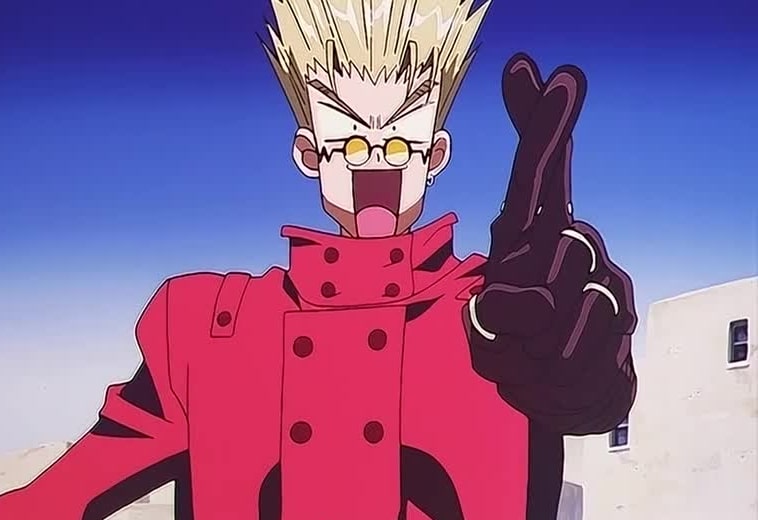
At this point, you think you have a pretty clear picture of Vash as a character. He IS a total badass, but he’s also our little goober, and a bleeding heart pacifist.
This is when the show starts to tease the REALLY weird shit with him.
On this desolate planet, the human refugees from Earth have only been able to survive thanks to resource generators known simply as “Plants,” which are considered a form of mysterious “lost technology” that the current generation of settlers don’t fully understand. Vash seems to have some sort of connection to the Plants, acting like he’s able to communicate with them. It doesn’t stop there. Vash is supposedly in his 20s, but there’s reason to believe he’s much older than that and just hasn’t aged a day. When confronted about destroying July, he seems to have no recollection of what actually happened… but he also can’t deny the possibility that he destroyed the city. He never really talks about his past, but he privately recalls Rem, a woman of unknown significance to him, as well as a mysterious man who he seems to be absolutely terrified of. In the first battle that genuinely gets Vash heated and puts him on the ropes, it’s revealed that his left arm has been a mechanical prosthetic with a concealed gun built into it this entire time.
And then in episode 16, we learn his right arm does… this.
It’s only here, two thirds of the way into the 26-episode anime, after the question of what the fuck is up with Vash has hit a critical mass, that the show decides to finally stop and depict his backstory. Set over 100 years ago aboard a colony ship full of cryogenically sleeping Earthlings before Gunsmoke was settled, we learn about the values Vash’s adoptive mother Rem instilled in him, the fact that the big bad of the show is his twin brother Knives, and the fact that neither of them are human. This pushes the show into somewhat darker and more dramatic territory for its final stretch of episodes, really getting into Vash’s head as he faces foes that put his skills and his ethics to the test.
Thus, the heart of the show is revealed to be this: Vash is a living weapon who instead chooses the path of peace, even at the cost of his own safety. He’s an immensely powerful being capable of immeasurable destruction, a walking nuke who once unwittingly leveled an entire city and was forced to take countless innocent lives. He could easily solve many problems by simply killing those he perceives as his enemies, like Knives would do. It would be completely trivial for him. But he strongly believes that he doesn’t have the right to decide who lives and who dies, and that his power doesn’t make him better than anyone else. This is what Rem always taught him - and Rem literally sacrificed herself to ensure these people could have a life on this desert planet in the first place. And so he vows to never take another life, preferring to come off as a fool and a coward than to make himself judge, jury, and executioner. The scars covering his body are a testament to the fact that he would rather take a beating than use his power to take a life. And the whole time he simply smiles through the pain.
(Yes, Vash is, in fact, a bit of a Christ figure. Maybe more than a bit.)
This slow rollout of information, gradually adding more and more layers to Vash as a character, is the main thing that really grabbed me about Trigun. It’s a ton of fun. Vash is a ton of fun. So, needless to say, it was a bit of a shock when Trigun Stampede chose not to do it like this at all.
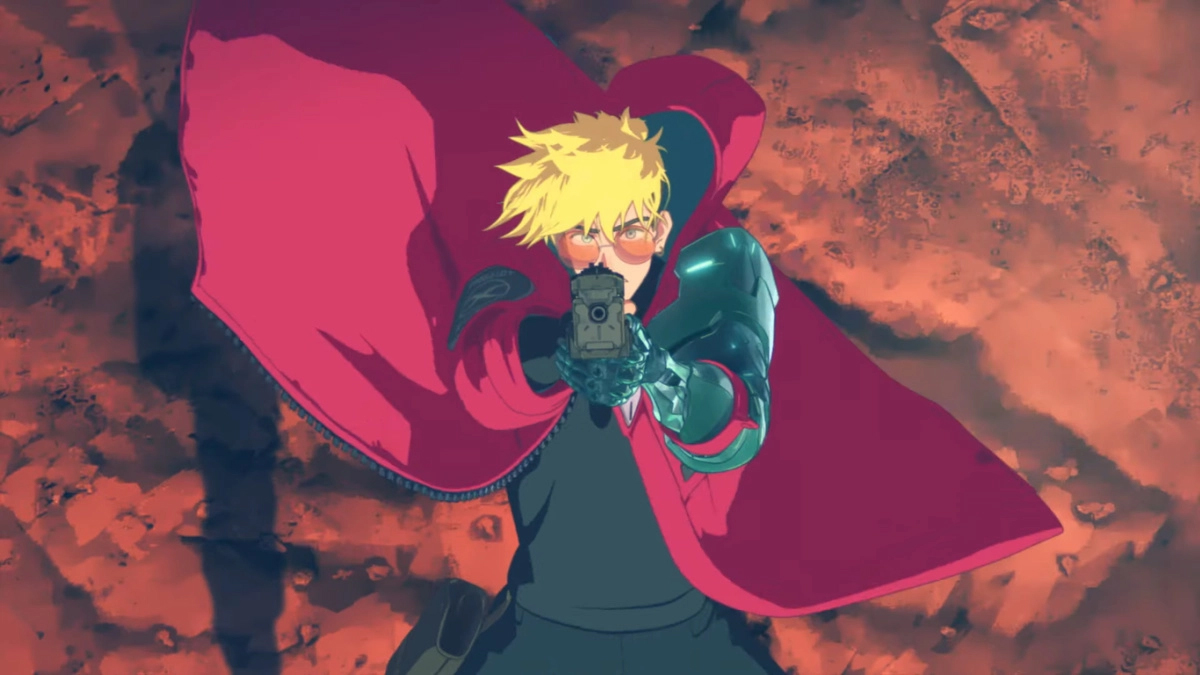
Stampede the Vash
Look. I didn’t want to be a Stampede hater. I went in having heard generally good things about it, and wanted to like it. I’m not someone for whom the ‘98 anime is a sacred text, something I have rose-tinted memories of watching on Adult Swim at a formative age. I literally finished watching it for the first time a week ago, and I’ll readily admit it has somewhat static animation, a few too many comedy scenes centered around Vash being a perv, and an abrupt ending that mostly just treats Knives as a final obstacle for Vash to overcome rather than his own character. There was room for improvement. And, yes, I saw all the annoying oldheads say Vash’s redesign looked “too gay” and write off the new version entirely from the moment it was announced just for being different. For a while there it became an anime culture war thing, where the kneejerk backlash made some super defensive about the show and its right to exist.
But I have to admit I just didn’t have a great time with Stampede. Hopefully the dust has settled enough that I can say that. And it's not because of the 3D animation, which I think looks great, or the character redesigns that are generally fine. It's because of the way they portray Vash as a character, and the handling of his arc. And, yes, this means I have to compare it to its predecessors, rather than judging it purely by its own merits. Sorry! It's a reboot. That's just how it is.
Right out the gate, Stampede declares that it’s a new take on the story that eschews much of the intrigue surrounding Vash. Where the ‘98 anime took over half of its run to delve into Vash’s mysterious past, the very first scene of Stampede depicts Vash, Knives, and Rem on a colony ship over a century ago, followed by a crazed Knives declaring that he was the one who set the fleet on a crash course to try and wipe out the humans. Coming off the old version, this evoked the same feeling that a reboot of Gravity Falls where the author of the journals was revealed in the very first scene would have. It puts the story in a completely different light.
This begins a trend where questions have to be answered as quickly as possible throughout the show, if they’re even allowed to be questions at all. Vash’s robot arm reveal? Impossible to do, it’s been redesigned so that it’s obviously mechanical from the moment you see it–and they took out the arm’s gun mode, removing the delicious irony of the pacifist literally having a concealed gun built into his body. (This also removes one of Vash’s three titular guns.) Where the original Trigun spent the entire series building towards a confrontation between Vash and Knives, here Knives shows up and starts violently slaughtering people in episode 3. Even the mystery of whether or not Vash is human is resolved midway through the season when they confirm he and Knives are immortal Plants. You could argue that they don’t bother treating these as twists because returning fans will already know about all this, but Stampede seems so wholeheartedly aimed at a new generation of viewers that I don’t think this explanation holds much water.
We also quickly discover another major change: the destruction of July, the defining moment of Vash’s past that hangs over the entire original anime, hasn’t happened yet. Instead, it’s saved for the finale of Stampede’s first season. Maybe that sounds clever on paper, but to me, so much of the central tension of the character is gone thanks to the decision to set all this before the July incident. This is a problem when they’re downplaying the comedy and trying to do a much more dramatic take on the character. Vash still has the title of “The Humanoid Typhoon,” but it’s unclear… why, exactly, if he hasn’t destroyed July yet? The show does very little to set him up as a legendary outlaw with a lot of misadventures under his belt by the time the story starts. It barely feels like he’s done anything up to this point other than wandering the desert as an aimless do-gooder. When Meryl asks him about his bounty, he explains that it’s a misunderstanding, and that he’s just been framed for a string of Plant thefts that his twin brother Knives has been committing.
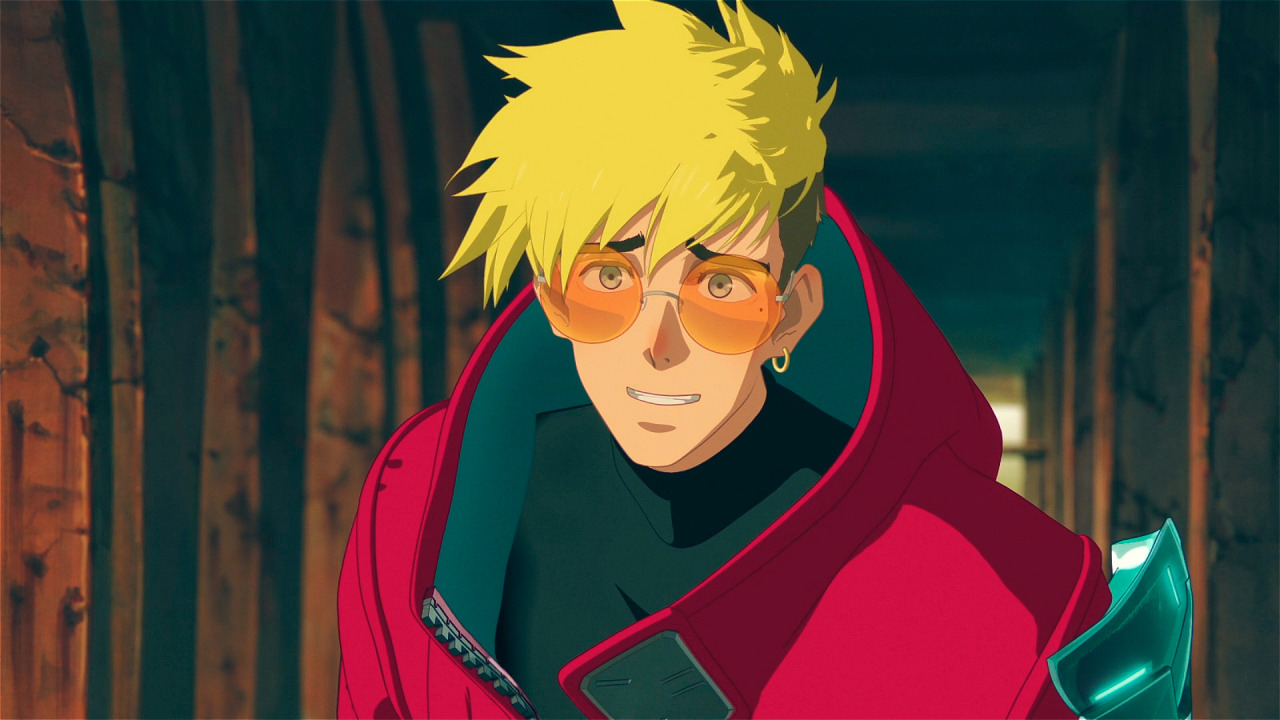
Most of Vash’s idiosyncrasies have been sanded away in favor of spelling out his straightforward good nature right from the start. We get a little of Silly Vash in the first two episodes. There’s, of course, his first big fight, where he mostly just runs around screaming and crying for help because he realizes he has no ammo, only to take out dozens of falling cluster bombs with a single shot once Meryl manages to get him a bullet. (This is likely homaging a gag in the ‘98 anime’s first episode, in which it’s revealed that his dramatic standoff from the show’s opening scene had actually ended with him realizing he was out of ammo and running away.) There’s also a fun little bit where Meryl has him tied up and Vash just casually slips out of it like he could’ve done so at any time, giving us a taste of the Vash who’s secretly always secretly three steps ahead of everyone else in the room. But these elements are pretty much dropped by the end of episode two, where he blatantly spells out that he’s just a kindhearted pacifistic hero who wants to save everyone, including his foes. He instantly becomes a much more serious character for the rest of the season. There’s no trickery, no sly Columbo energy, no mystery to whether or not we’re seeing the “real” Vash. Vash immediately just looks right into the camera and tells us who the real Vash is in a way that the original character would never do.
Johnny Yong Bosch returns to play Vash in the English dub, but he’s now doing a very stereotypical hushed soft boy anime dub voice, as opposed to his original portrayal that was closer to his natural speaking voice. He’s extremely one note, but it’s hard to blame Bosch for this when the show itself is so one note, constantly fixated on portraying Vash as this poor, sad, sensitive guy who’s just caught up in all this because his brother is so darn evil. Yes, '98 Vash also had many sad moments of introspection and mourning, or moments where he was reluctant to fight, but those were dramatic beats the story built towards once his arc reached an emotional low point, not a mode of storytelling he was in for almost the entire series. Even the new opening just has Vash moping around the desert while some sad Post Malone type shit plays. He feels less like the mythical figure that the ‘98 anime made him out to be and more like a passive character who events just kind of happen around so that he can feel bad about it all. He often doesn’t even feel all that important to the events of the story, with how much focus has been given to Wolfwood, Knives, and the Gung-Ho Guns.
And not ONCE does he hit us with a “love and peace”!!!
This version of Trigun seems eager to rush through the early parts of the story, abandoning slow burn character development and mysteries in favor of getting to “the cool shit” and "the dramatic shit" as quickly as possible. But as I read more of the manga, I kind of started to see where the writers of Stampede were coming from, because, like… the manga also kind of does this?
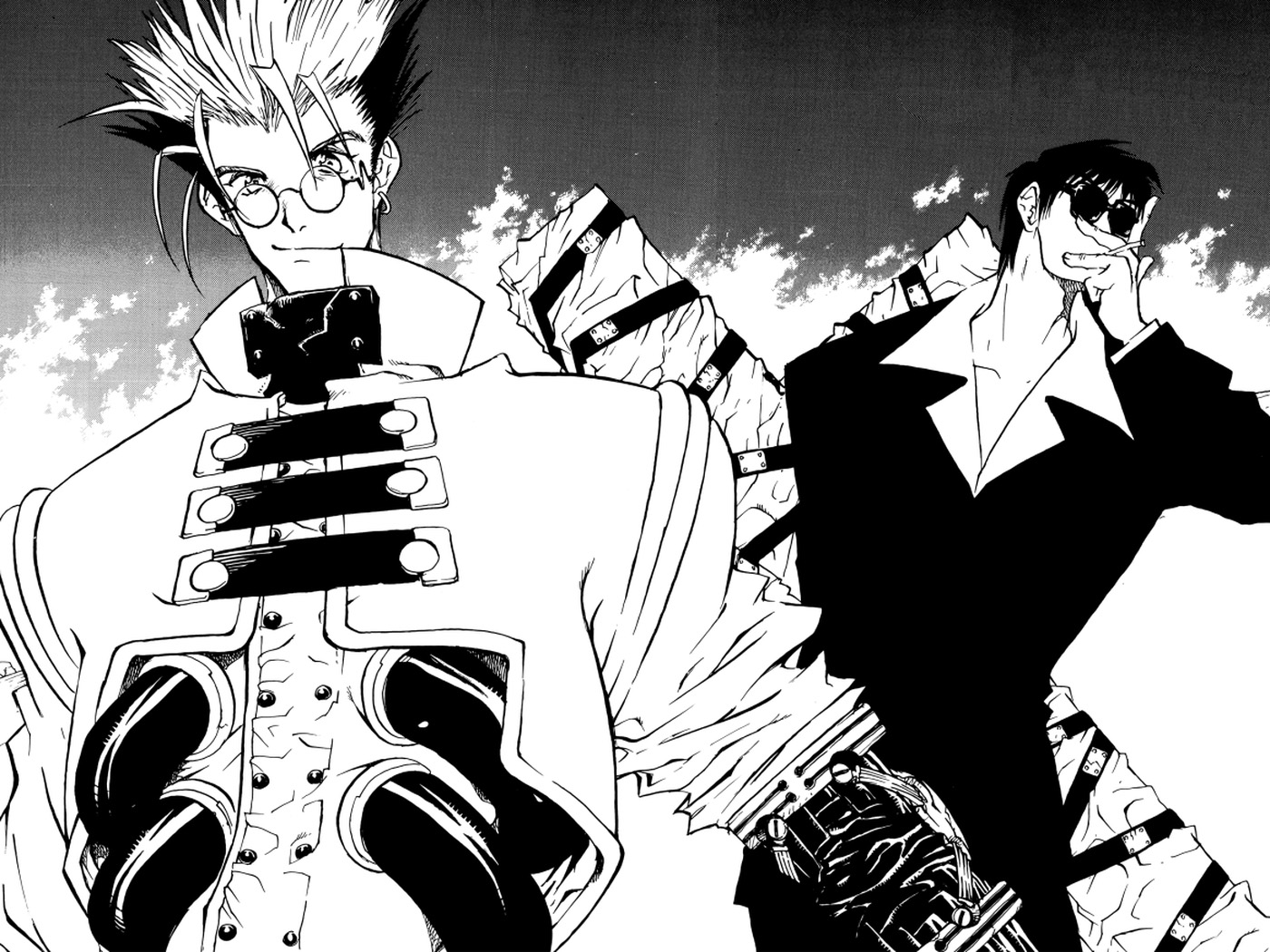
The manga is a different beast
The early parts of the manga aren’t bad, but they’re messy.
For those unaware, Yasuhiro Nightow’s original Trigun manga only ran for 20 chapters before the shounen magazine it was published in came to an end. The series would soon pick up where it left off as a seinen manga with more mature content under the new title Trigun Maximum, which would continue to run for about 100 chapters from 1997 all the way to 2007. This timeline means the 1998 anime was produced when less than a quarter of the manga’s total story had been written, which is why it expands on early events and eventually diverges from its source material in a similar manner to the original Fullmetal Alchemist anime.
I’m unsure if Nightow knew that the magazine would be ending months in advance and decided to speed up the plot, or if he was just another mangaka throwing shit at the wall early on to see what his readers liked, but either way, the initial 20-chapter Trigun manga moves at a breakneck pace. It’s always jumping from fight to fight, introducing new characters and plot hooks, and escalating the stakes extremely quickly, especially compared to the anime. Knowing that the series was never hugely popular in Japan, you can almost see Nightow panicking and deciding to dilute the western vibes ASAP, amping up the sci-fi elements, the angelic imagery, and Vash’s fated rivalry with Knives. It ends up feeling closer to Guilty Gear than a Sergio Leone movie. Lots of reveals from the back half of the anime occur earlier in the manga to get to these elements more quickly. Vash gets his first flashback to Rem and Knives on the colony ships as early as chapter 7, and he’s then shown communing with an angelic Plant and sprouting wings of his own in chapter 9. Legato and the Gung-Ho Guns are set up as long-term villains serving under Knives in chapter 13, and then Vash is already facing Knives and awakening his Angel Arm in chapter 20. And it somehow keeps escalating from there throughout Maximum's 14 volumes!
While that Goofball Cowboy Trickster Vash I fell in love with early in the ‘98 anime sort of exists in the manga, it ends up feeling like an incredibly minor part of the character because Nightow moves on from that mode of storytelling so quickly. Too quickly, if you ask me. A certain type of anime fan may see that only nine episodes of the ‘98 anime are directly adapted from manga chapters and declare that the other 17 are “filler,” but Trigun is a poster child for how “filler” can be a good thing. I think the story of the ‘98 anime is better for the added time it spends in spaghetti western mode, for the greater focus on Meryl and Milly as POV characters, for the way it very slowly and carefully reveals to the audience what Vash is capable of and sits on certain twists longer to make him more mysterious. The ‘98 anime feels like a series that makes a deliberate shift towards darker, more dramatic storytelling with more overt sci-fi elements in its back half, treating the Gung-Ho Guns’ arrival as a big “oh shit” moment where suddenly Vash meets his match and has to get serious. The manga feels like a story that spun its wheels for a little bit before its inexperienced creator settled on making it a dark, moody, violent sci-fi action series with apocalyptic stakes and heavy Christian overtones.
As such, manga Vash quickly becomes less this:
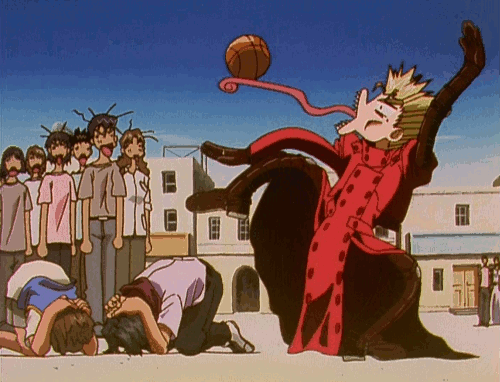
And more this:
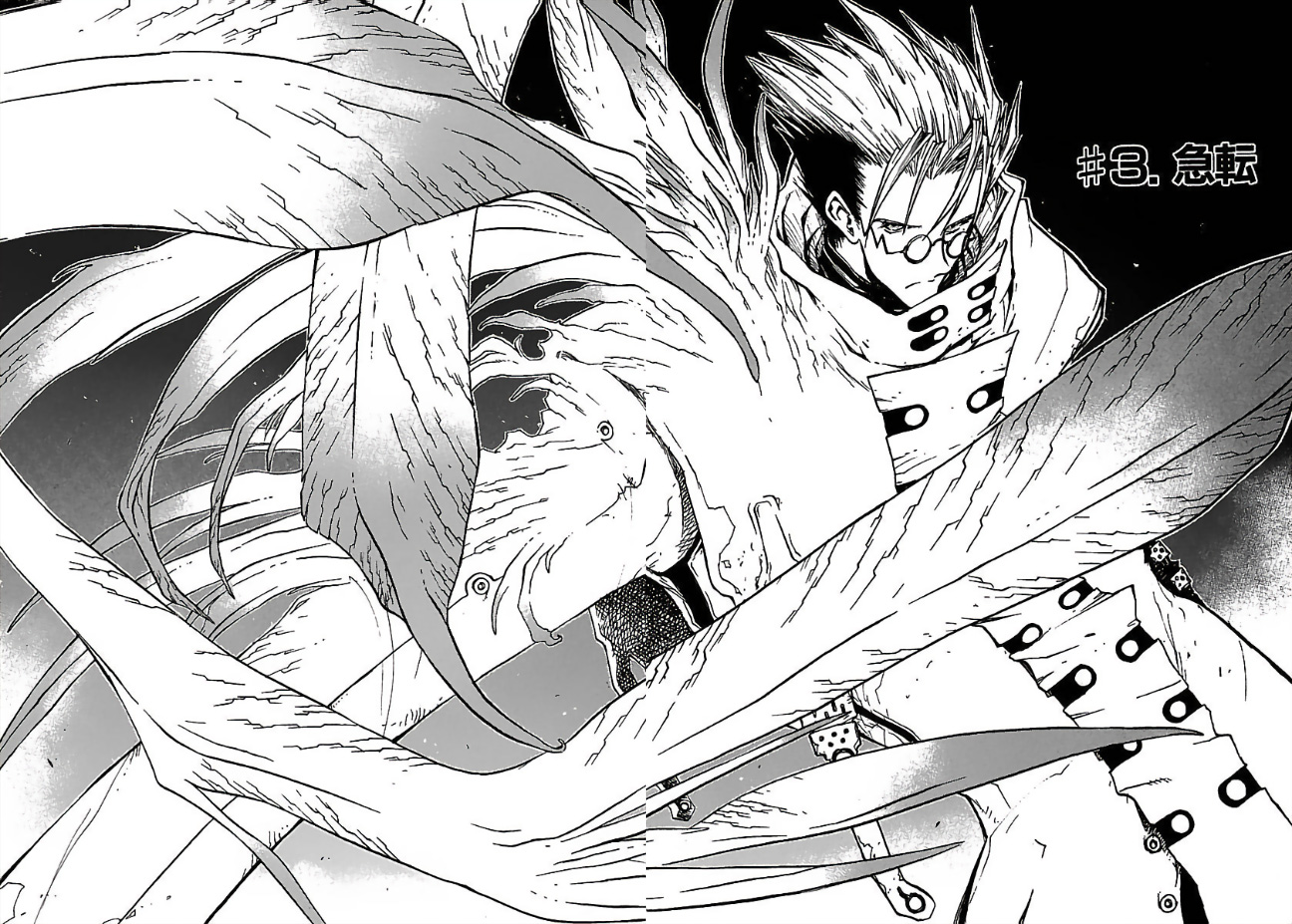
But, like I said, because the comedy misadventures are downplayed so quickly in the manga, it makes me kind of get why Stampede chose to do the same thing. I don’t necessarily love it in Stampede, but I can see how someone looking at the manga as a whole could think that emotionally burdened pacifist Vash who smiles through the pain and repeatedly clashes with Knives is more important to the overall essence of the manga than the Goofball Vash from the first few chapters.
But still, I don’t think Stampede quite captures Vash’s character from Maximum. While, yes, the manga’s Vash is a kindhearted pacifist, he also tends to face his battles head on with a lot of determination. It’s just that, y’know… he’s also gonna try not to kill anyone in the process of fighting. He gets pissed off! He threatens his enemies! But he remains true to his ethics in spite of that. That’s, like, the entire story! Stampede Vash feels more meek, passive, and reluctant to do much of anything. He’s not a force of nature that the story pivots around so much as the guy who happens to be brothers with the villain, and also he does cool action hero stuff sometimes, when he feels like it. He spends most of his fight scenes trying to reason with his opponents and lamenting how they shouldn’t even be fighting at all, rather than just beating them in a cool but nonlethal way. He can’t even fight cartoonish one-off villains like the Nebraska family anymore without getting all teary-eyed and preaching about how he wants to save them and making the town they were just terrorizing make up with them. And that's in the second episode! It’s an overcorrection.
Getting back to the manga, though: it did slowly win me over. It’s very different from the ‘98 anime, but Maximum is just plain cool. I am famously a JRPG liker, so I get why Nightow was eager to push the angelic body horror stuff with the Plants and turn Knives into a godlike being.
Like, look at this. This is awesome.
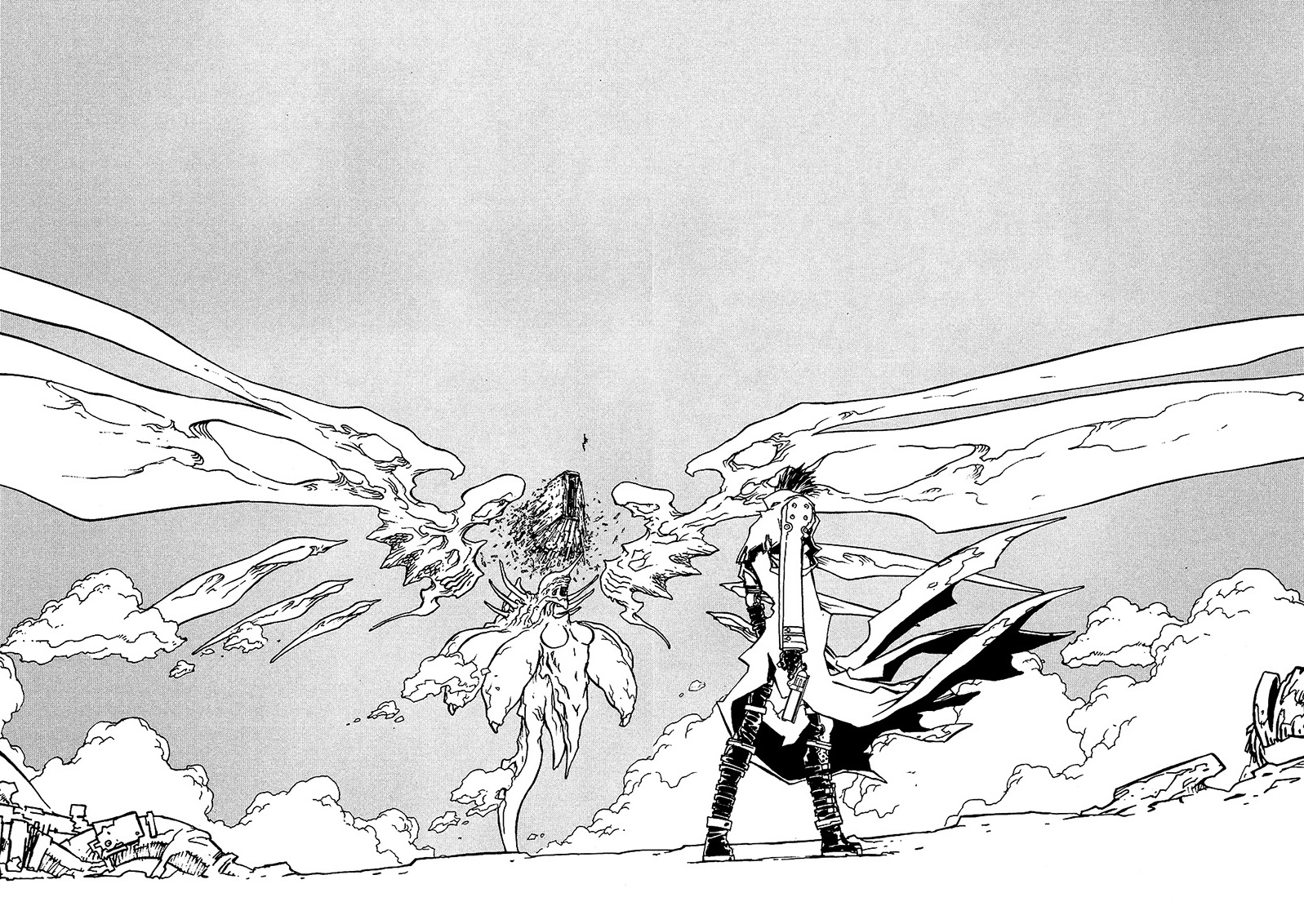
But while Nightow is undoubtedly good at creating cool images and cool fight scenes, he’s not quite as skilled when it comes to making legible fight scenes. Trigun Maximum has much more emphasis on long, dramatic, violent, battle manga-ass battles compared to the spaghetti western showdowns of the ‘98 anime, but they’re comprised of busy panels with detailed character designs, exaggerated posing, gigantic sound effects, complicated weapons, extreme closeups, and flurries of gunshots. Who’s winning right now? What did Vash just do? What information was I supposed to glean from that two-page spread that was treated as a major turnabout moment in the battle? Did that character just die? I often found myself asking questions like these, especially with how little Nightow uses text in most fight scenes compared to many of his peers. I’m not sure there’s a single named attack in this entire series, and it’s low on commentary to explain what’s happening and the extent of characters’ powers and things like that.
What are the specifics of what’s going on on this spread, for example? Damned if I know!
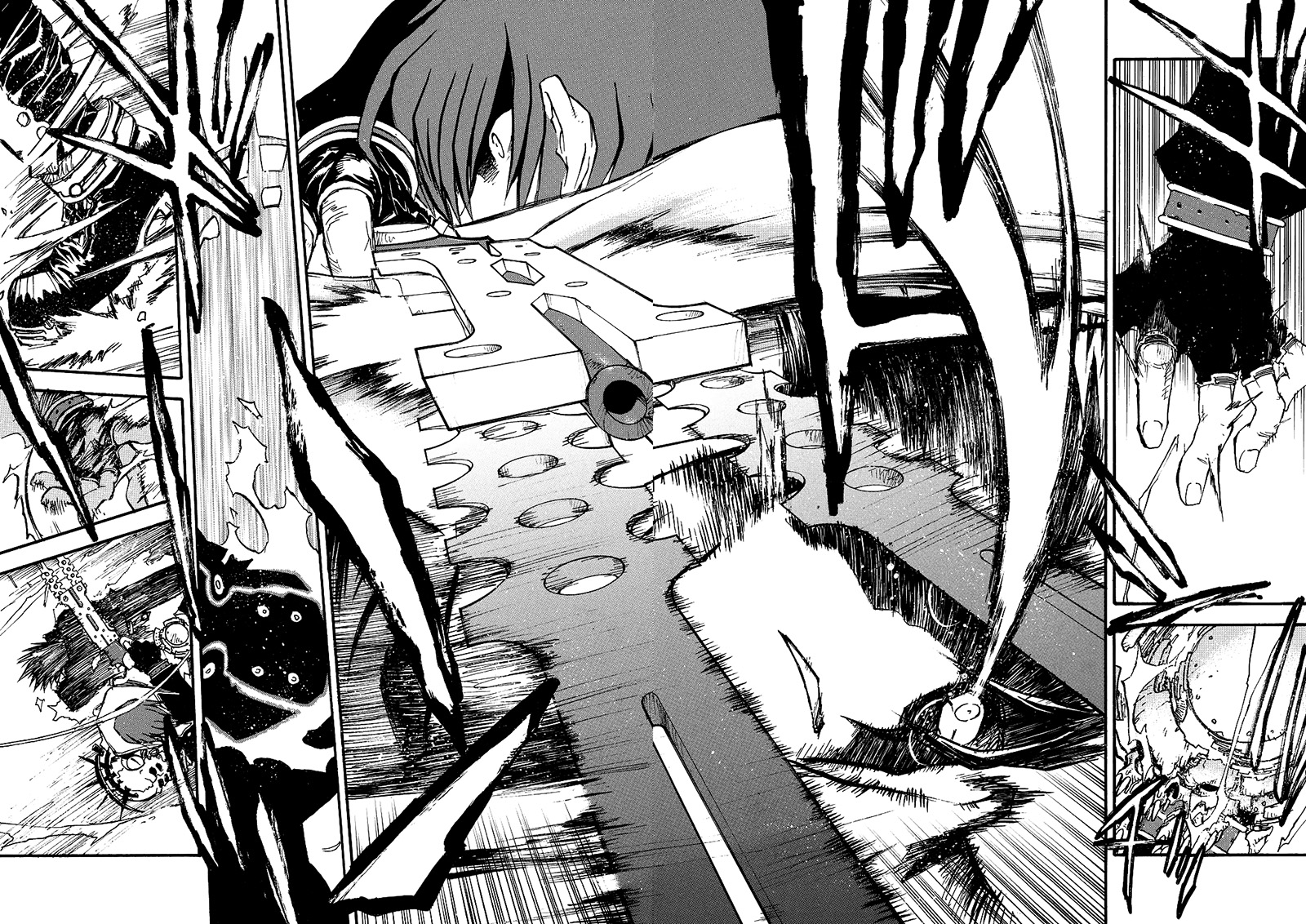
This is, undoubtedly, an area where Stampede was able to improve on the manga, with Orange’s lively 3D animation capturing the dynamic and stylish intent of Maximum’s battles while also being possible to actually follow. I can’t complain about the fights in Stampede. They’re good.
But, okay, I’ve said enough about Vash. What about the other characters? How does Stampede handle them?
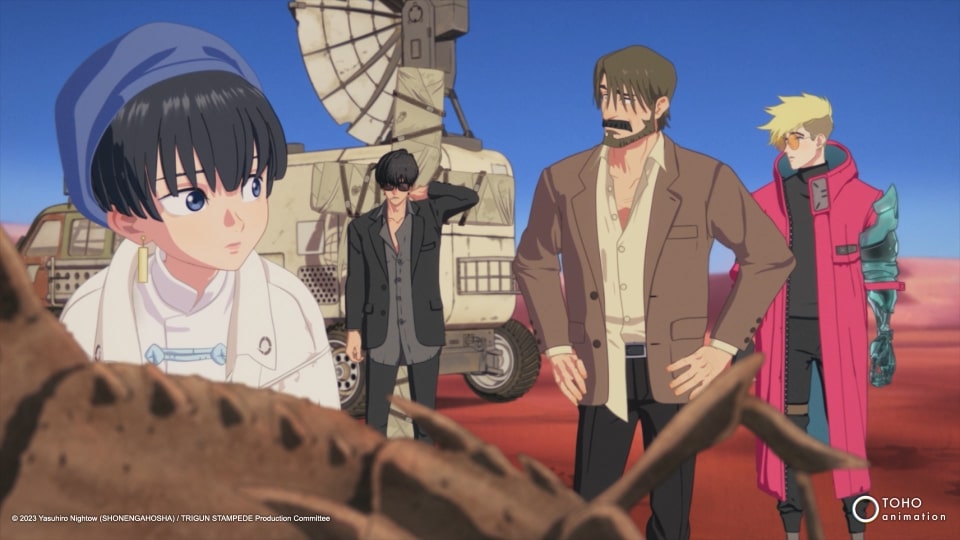
Wolfwood, Meryl, and… Roberto?
Wolfwood is probably the highlight of Stampede, though he’s not without his issues.
Like with Vash, any mysteries surrounding the character are dispelled as quickly as possible. Where ‘98 Wolfwood and manga Wolfwood took a few appearances to reveal that the cross he carries around is actually a giant gun, Stampede Wolfwood whips it out in his debut episode. Where ‘98 Wolfwood’s loyalties were treated as a big twist late in the series, revealed only after he had already grown attached to Vash and co., this too is information established by the end of his debut episode in Stampede. Hell, for a while I wasn’t even sure if Wolfwood was really a priest in the ‘98 anime, and not knowing that was fun! Wondering if I’d get a better picture of what he was really up to every time he and Vash “coincidentally” crossed paths was fun! Stampede Wolfwood doesn’t have that. It doesn’t help that he’s much less affable than his ‘98 anime counterpart, with a very gruff new voice in the English dub and a much more pissed off attitude at all times that makes him much more of a typical shounen anime deuteragonist. (also they took his nose)
Still, I found him to overall be a fairly faithful adaptation of the manga character. His dynamic with Vash is about as good as it’s going to get without a more playful Vash. It’s as fun as ever to see him swing that giant cross-shaped gun around in fight scenes, which the dynamic 3D animation can do a lot with. And, of course, he now has his backstory from the manga and his rivalry with Livio, which I think adds interesting wrinkles to him as a foil for Vash. Vash is seemingly a naive idealist, when really he’s an ageless being with over a century of harsh life experience under his belt to back up his beliefs. Wolfwood considers himself a jaded realist, when really he has much less experience than he lets on due to the fact that his body was modified to make him age faster. That’s a fun dynamic that the ‘98 anime couldn’t fully depict, what with Wolfwood’s backstory not being written at the time and all.
Meryl and Milly fare worse here–particularly poor Milly, because she’s not even in it. Yes, yes, many have already complained about how everyone’s favorite tall woman with a sunny disposition and a gatling gun was cut from Stampede, and yes, they foreshadow the fact that she’ll be in season 2. This is a dead horse. But still, I don’t like it! Milly was one of the most unique parts of the series, and removing her makes the first season worse.
With Milly absent for now, Meryl (who’s a journalist now instead of an insurance agent, possibly referencing her and Milly’s career change in the manga’s epilogue) is paired with a new character, a gruff old reporter literally named Roberto De Niro. I hate him. Roberto is easily one of the worst parts of the show, a character who adds nothing to the cast. He’s a cynical, world-weary man who drinks and smokes and is supposed to be a foil to Vash’s idealism… which is already what Wolfwood is there for. He’s a normal human who’s initially skeptical of the stories surrounding Vash and is reluctant to get roped into his misadventures… which is what Meryl was there for in the original anime! He even has Meryl’s derringer! What does this leave for Meryl to do? Well, not much. She gets to be the passionate but slightly naive young reporter, sort of an aspiring Lois Lane or an April O’Neil type, who Roberto talks down to and calls “newbie” every time they’re on screen together. Great. Thank god Roberto’s dead by the end of the season. Either way, they do basically nothing with this journalism angle.
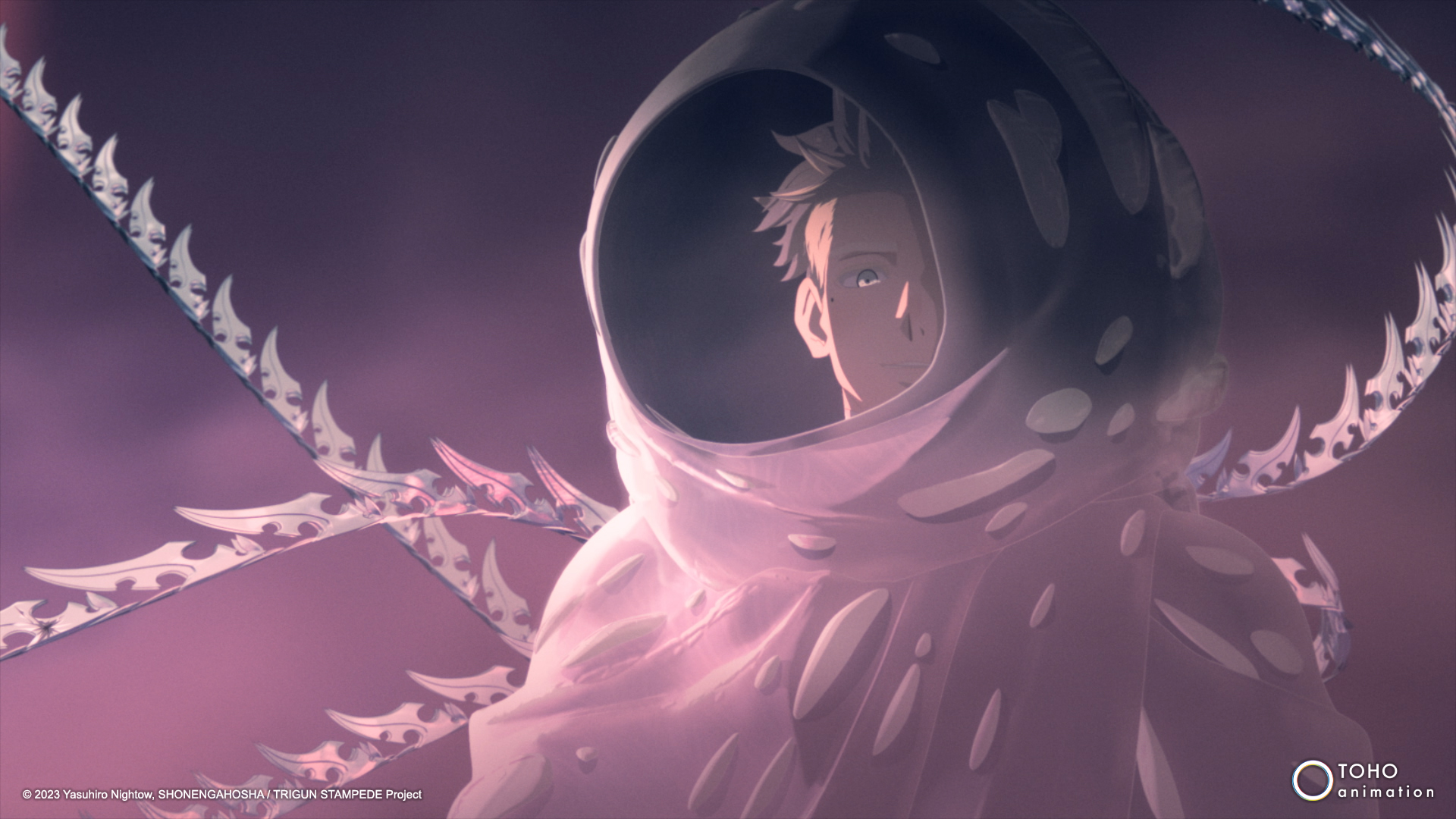
Millions Knives and his millions of knives
Much has already been said about how much more fleshed-out and manga-accurate Knives is in Stampede, so I won’t belabor that point on a post that’s already long enough. It’s true. He’s pretty good in this. The tradeoff with how quickly Stampede introduced Knives and started getting into the Plant stuff is that they can start elaborating on Knives’ motivations and his ideological battle with Vash over the future of their kind much earlier. And that stuff is good. I get why they saw that stuff from the manga and just wanted to get to it as quickly as possible. I also like that Rem is painted as less of a saint here than she was in the ‘98 anime. She had good intentions, but you can see how telling Knives to hide his nature as a Plant while praising Vash for blending in with humans better fucked him up.
I could get into the weeds with the Plants and the question of whether or not they should be considered slaves and if the fact that they aren’t fully sentient makes things better and yada yada yada, but honestly I like the way that stuff is resolved in the manga well enough that I’m like, you know what? It’s fine. It’ll probably be fine. Just do what the manga did in season 2 and it’ll be a good conclusion.
I do hate his stupid new costume, though. It just looks like a fish suit to me. I’m glad he doesn’t wear it all the time. Also it’s funny that they made him literally use millions of knives
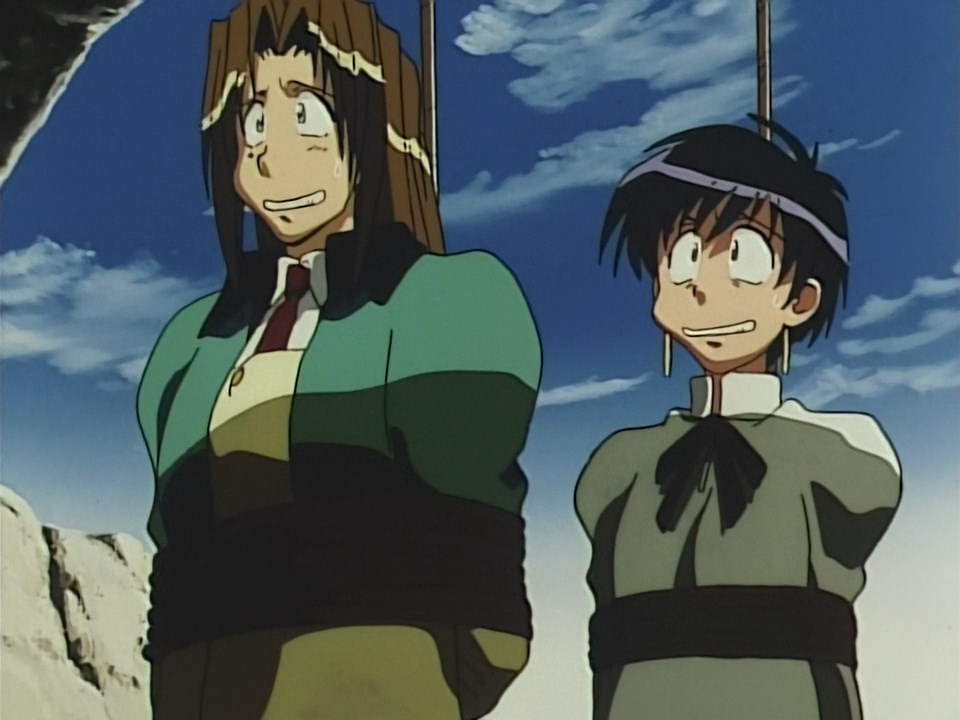
In conclusion
In the end, I still find myself thinking that the ‘98 anime is my favorite take on Trigun, with Stampede being my least favorite and the manga being somewhere in the middle. Sometimes, the anime that diverges wildly from the manga it's based on is simply better than its source material.
I can see why people like Stampede, particularly new fans with no preconceived notions and manga readers who are excited to finally see certain ideas from Maximum brought to life on the screen. There’s some fun stuff in there, and it looks great. I do have mildly more positive hopes for the second season (assuming that’s what they mean by an imminent “final phase of the story”). Roberto’s out, Milly’s presumably in, and cool stuff from way later in the manga is being teased. I just really didn’t care for the way Vash was written in this first season, and I unfortunately don’t see his one-note sad, soft, mopey nature changing anytime soon given the note we last left him on.
But, like I said up top, there's no one definitive version of Trigun. I’m glad I took the time to check out all three takes on the story, because each individual version helps you form a more complete picture of the platonic ideal of Trigun. In a perfect world, my ideal Trigun anime would probably have the episodic structure and slow burn character development of the ‘98 anime to start out, and then shift to Trigun Maximum’s version of Vash’s struggles with Knives and the Gung-Ho Guns. The manga’s ending and epilogue, in particular, are much more satisfying than the original anime’s. However, on top of this, it would also have Stampede’s stylish action animation, so that I can actually tell what the hell is going on in the fights. This doesn’t currently exist, though, and I’m not waiting up for a third anime adaptation anytime soon, so I’ll just continue to appreciate all the individual parts I like from the versions that do exist. Thank you, Mr. the Stampede, for your service.
Oh, and also there wasn't enough of the little black cat in Stampede. Love that little black cat. Justice for Kuroneko.
Also Meryl and Milly should be gay, obviously.
Love and peace!

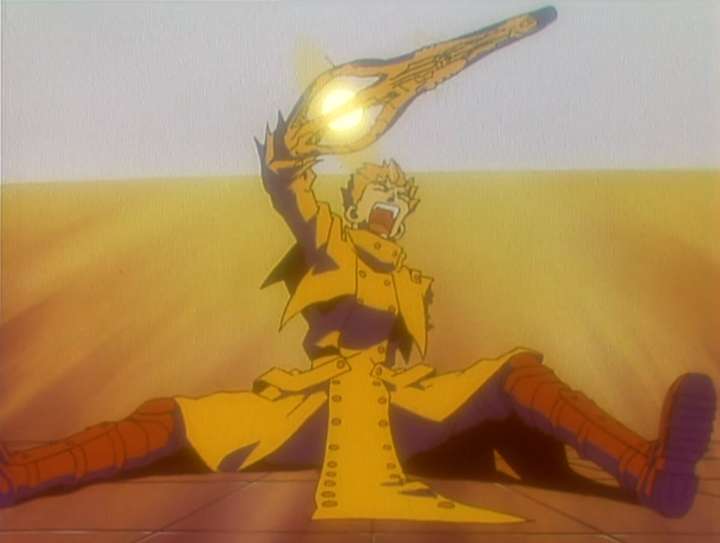
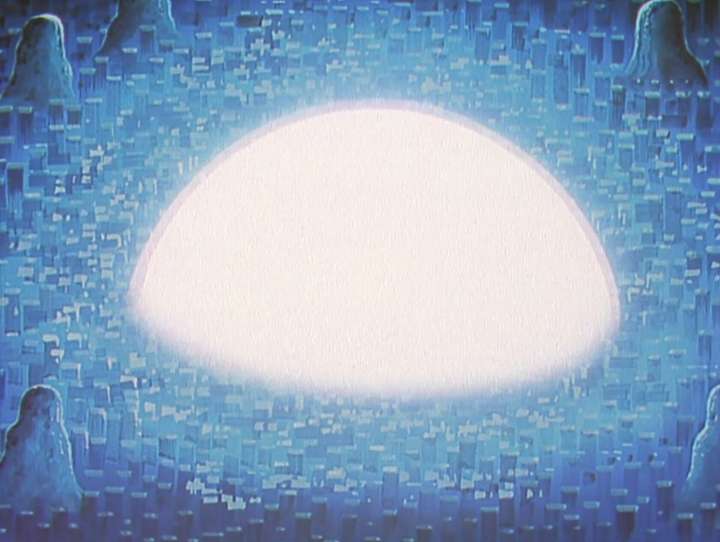
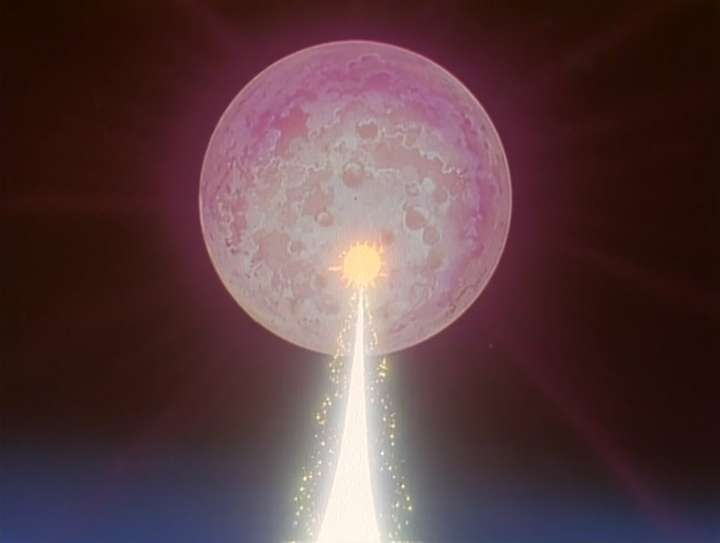
Comments